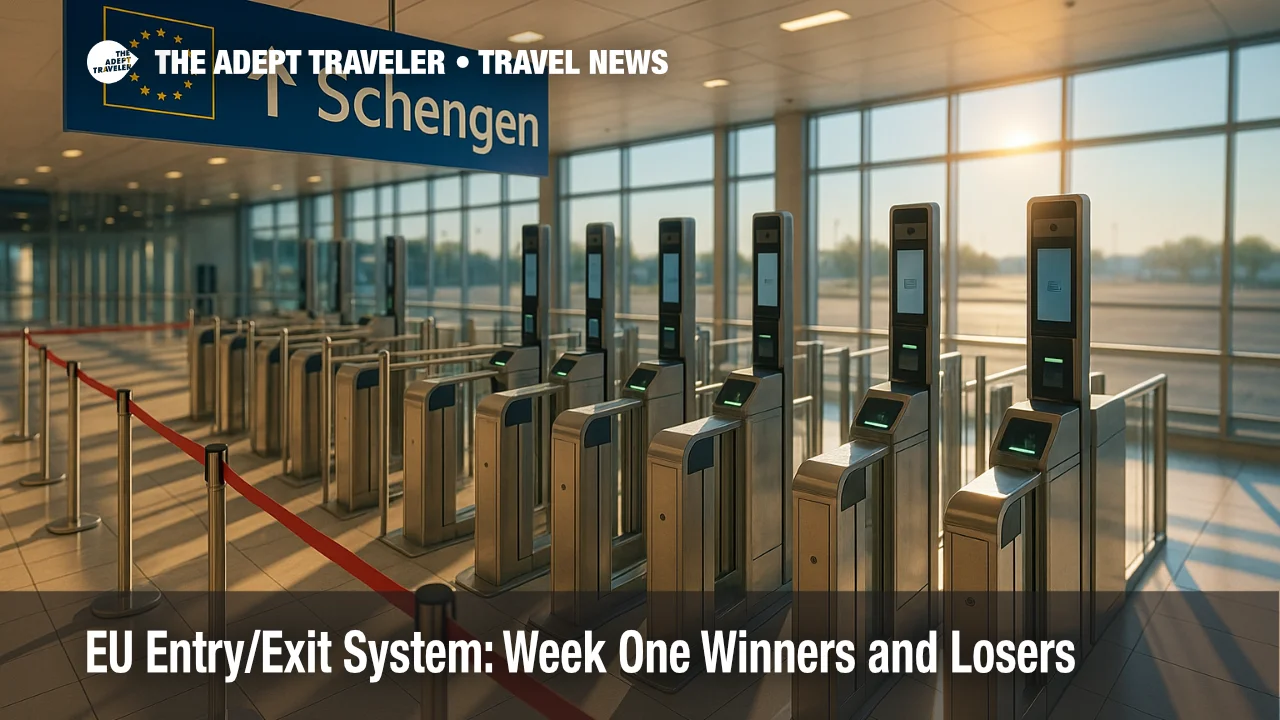EU Entry/Exit System: Week one winners and losers

Key points
- EES launched October 12 with a six-month phased rollout
- Düsseldorf and Oslo report orderly starts
- Brussels sees multi-hour queues for non-EU travelers
- Croatia's Bajakovo crossing experiences early delays
- Schiphol staggers start to November 3 to ease pressure
The European Union's Entry/Exit System went live on October 12 with a six-month, phased rollout across external borders. The first week delivered a split screen. Some hubs reported orderly processing as officers and equipment came online in stages. Others faced long lines as first-time biometric registration met peak flows. For travelers, the takeaway is uneven performance by country and border type, with airports generally improving fastest where rollouts are deliberately staged.
EU Entry/Exit System, week-one snapshot
The European Commission and eu-LISA confirmed EES entered operation on October 12, replacing manual passport stamps with electronic records for non-EU short-stay visitors. Member states are activating the system progressively through April 10, 2026. Germany chose Düsseldorf Airport (DUS) as its first live site before expanding to Frankfurt and Munich once operations stabilize. Norway's first location is Oslo Airport Gardermoen (OSL). The Netherlands began with two maritime posts and signaled Amsterdam Schiphol Airport (AMS) will switch on November 3, spreading demand away from the launch week. These choices reflect a measured strategy: begin where volumes are controllable, then scale.
Latest developments
Reports from Brussels Airport (BRU) described multi-hour queues for non-EU travelers as the system and staffing ramped up, compounding a difficult local week. On land, the Serbia-Croatia crossing at Bajakovo saw early lines as travelers completed first-time fingerprint and facial enrollment. By contrast, Düsseldorf's staged launch limited disruption, and Oslo's initial activation remained narrow by design. UK departure points tied to Schengen checks, such as Dover and Eurotunnel, are phasing in segments of traffic before expanding to cars and broader passenger flows later in the year.
Analysis
Week one suggests phased activation beats big-bang starts. Airports and border points that limited scope, communicated clearly, and sequenced traffic types saw fewer headaches. Where launch coincided with local labor or operational pressure, delays spiked. Expect a learning curve: the most time-consuming step is the first registration, not subsequent crossings that rely on stored biometrics.
For travelers over the next six months, plan conservatively. Add buffer time on arrival, especially at land borders and early-stage airports. Review airport guidance before travel and watch for site-specific start dates, like Schiphol's November 3 activation. If your itinerary touches known pinch points, consider adjusting flight times to off-peak arrivals. You can also monitor day-of bottlenecks in our running coverage, including Flight delays and airport impacts: October 17, 2025.
Final thoughts
The EU Entry/Exit System is a multi-month transition. Early winners, such as Düsseldorf and Oslo, are using phased scope and clear messaging. Challenged nodes, including Brussels and the Bajakovo land crossing, should stabilize as staffing, signage, and kiosk flows improve. Until April, treat the EU Entry/Exit System as a work-in-progress and plan time accordingly.
Sources
- The new Entry/Exit System went live on 12 October, European Commission
- Entry/Exit System successfully connected across Europe, eu-LISA
- EU begins gradual rollout of digital border system, Reuters
- EES implemented at Düsseldorf Airport, Düsseldorf Airport
- Entry/Exit System, Norway Ministry of Foreign Affairs, Oslo rollout
- The Netherlands starts implementing EES at seaports; Schiphol start Nov. 3, Government of the Netherlands and Schiphol, https://www.schiphol.nl/en/aviation-partnerships/european-entry-exit-system/
- Brussels Airport guidance on gradual EES implementation, Brussels Airport
- Queues at Bajakovo as EES begins, Ekathimerini and HRT, https://glashrvatske.hrt.hr/en/domestic/new-schengen-entry-check-system-to-come-into-force-today-12376794
- Local report of queues at Brussels Airport, The Brussels Times
